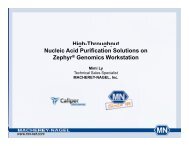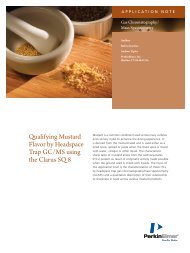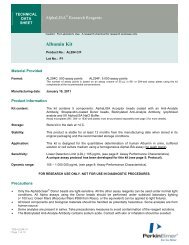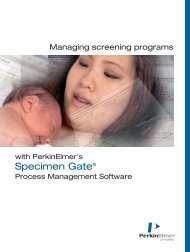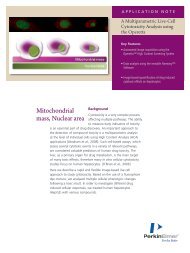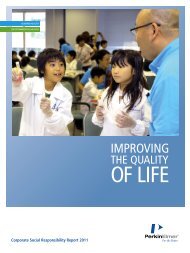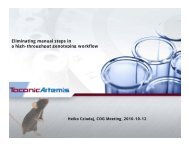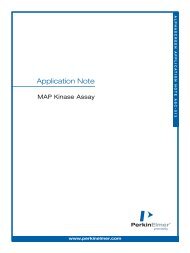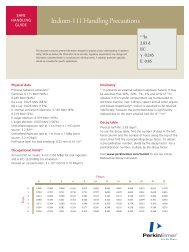AlphaLISA Assay Development Guide - PerkinElmer
AlphaLISA Assay Development Guide - PerkinElmer
AlphaLISA Assay Development Guide - PerkinElmer
Create successful ePaper yourself
Turn your PDF publications into a flip-book with our unique Google optimized e-Paper software.
Appendix I: Summary of <strong>AlphaLISA</strong> <strong>Assay</strong> <strong>Development</strong> Steps<br />
A. Identify optimal antibody pair<br />
B. Optimize assay conditions &<br />
Determine assay characteristics<br />
Determine optimal:<br />
Biotinylate all antibodies<br />
(see: IV. B)<br />
Conjugate all antibodies to<br />
<strong>AlphaLISA</strong> Acceptor beads<br />
(see: IV. C)<br />
<strong>Assay</strong> volume (see: IV. F1)<br />
Incubation time (see: IV. F2)<br />
Order of addition (see: IV. F3)<br />
<strong>Assay</strong> buffer (see: IV. E)<br />
by generating analyte calibration<br />
curves in <strong>Assay</strong> Buffer<br />
Test all possible antibody<br />
combinations: Titrate the<br />
biotinylated antibody in<br />
<strong>AlphaLISA</strong> (see: IV. D)<br />
Determine assay characteristics<br />
from calibration curves<br />
performed in <strong>Assay</strong> Buffer and<br />
in Matrix Solution: detection<br />
limit, dynamic range,<br />
reproducibility (see: IV. D3)<br />
C. Determine analyte level in unknown<br />
samples<br />
Perform an <strong>AlphaLISA</strong> analyte<br />
calibration curve in Matrix<br />
Solution (see: IV. G)<br />
Interpolate level of analyte<br />
from calibration curve<br />
(see: IV. G)<br />
- 24 -



